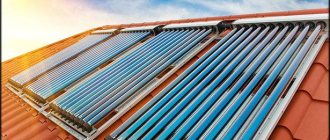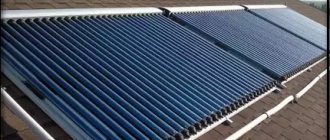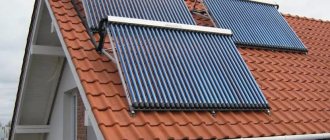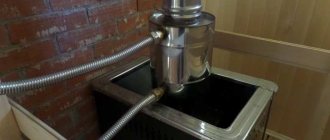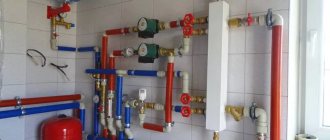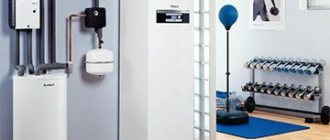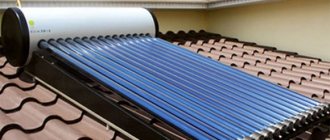It is possible to assemble an alternative room heating system at minimal cost, but with impressive efficiency, using an airborne solar collector. Such devices in the West are produced on an industrial scale, and the distribution density, for example in Belgium, reaches 0.4 m2 per person. In Russia, airborne solar collectors are practically unknown; they are collected by artisans for personal use. According to statistics, each resident of the Russian Federation accounts for only 2 square centimeters (!) of the area of such structures.
Air collector device
Solar heating does not convert energy using photocells into electricity, but concentrates heat, transferring it inside the house.
Heating systems that utilize solar heat are used for local heating of air.
Through the installed channels, a stream of hot air circulates in the solar heating system, thereby heating the interior spaces.
How to make air heating based on buleryan
The Buleryan stove was developed for Canadian lumberjacks. Due to its unique characteristics, it spread very quickly, and today buleryan is used for heating homes, factories, garages, greenhouses and other facilities.
The operation of the furnace is based on the principle of gas generation, i.e. “smoldering” combustion mode with oxygen deficiency. From below, cold air enters the openings of the furnace, and air heated to 60 - 80 degrees comes out of the pipes of the upper part of the furnace. The combustion mode in such a furnace is full, i.e. with afterburning of combustible gases in a furnace with air supply. The stove is very economical - one load of firewood lasts for 6 - 8 hours.
Do-it-yourself air heating of a private house from Buleryan is achieved by connecting air ducts to the stove pipes and distributing heat through air ducts throughout the house. Ducts can be made of corrugated aluminum or tin. Air ducts transport hot air only from the furnace; there is no return flow, which reduces heating efficiency.
The photo shows a buleryan stove. Made in Canada
Design options
There are two types of solar heaters that heat using the greenhouse effect:
- Passive - provide natural air circulation through channels.
- Active – carry out the transfer of the working environment forcibly.
The designs of heating systems based on solar collectors also differ in the principle of air supply. When the air mass is captured from outside, after which it is heated and released into the premises, this is called a ventilation system.
If cool air that needs heating is taken from inside the room, and after warming up in the collector it is returned, then this is a recirculation option.
How to make air heating from cans
Do-it-yourself air heating of a private house from cans is an example of self-manufacturing of an effective heating system from scrap materials.
Making air flows
- You will need 196 soda cans, which need to be washed and holes made at the bottom and top.
- Fasten the cans together with silicone, making a pipe of 14 cans. There are 14 columns of 14 cans in total. These are the channels through which warm air will enter the house.
Making a collector box
- For the box you will need plywood and boards, PVA glue, high-temperature silicone, and mineral wool for insulation.
- The board needs to be cut to size, the joints must be nailed and glued.
- The finished dry box must be insulated with mineral wool.
- In the top wall you need to make 14 holes to fit the size of the can. These are places where warm air collects.
Manifold assembly
It is better to see the assembly of the collector and its preparation for operation - the whole process is shown in detail in the video at the end.
The collector is capable of heating the air to 70 - 80° C. The use of such a collector can significantly save the consumption of natural gas and electricity for heating.
This is what a collector made of aluminum cans looks like
The greenhouse effect works
Panel air collectors that heat rooms using solar energy are an inexhaustible source of free heat.
Modules of various sizes can be used in greenhouses and country houses, in private houses, at tourist centers, in cottages and city apartments. A medium-sized block produces up to 2 kW/hour, which is enough to create comfortable conditions in rooms in the off-season.
Reviews of the air solar collector say that even in winter, the device continues to work effectively, allowing the fuel consumption of the heating boiler to be reduced by half.
- The operating principle of the air collector is based on the laws of physics, familiar to everyone from school.
- By absorbing visible light passing through the glass, the surface heats up and begins to generate thermal radiation, for which glass is an insurmountable barrier.
- Heat accumulates under the glass, heating the air, which begins to rise. Due to natural circulation, heat is transferred indoors.
If necessary - when the heated air moves too slowly, having time to release the acquired heat to the outside environment - the system is supplemented with a fan powered by electricity from photocells.
So, the standard collector panel is a system of adsorbers placed inside a heat-insulated box, closed with a transparent lid (glass unit, polycarbonate). The use of glass allows for heat extraction even in Siberia. But polycarbonate is also applicable. Although it provides lower efficiency, it costs less.
The adsorber is made of aluminum or copper with a selective coating that absorbs maximum energy.
What it is
The purpose of an airborne solar collector is to collect solar energy and transfer it to a coolant, in our case, air.
Such devices are most in demand in Switzerland, Japan, Canada and Australia.
In Russia, air heating using solar collectors is used only as an addition to the main one. This is explained by the climatic characteristics of our country.
Revolutionary invention
Engineering thought does not stand still. Recently, developers have proposed a revolutionary version of the solar air collector, which, due to its ease of manufacture and high efficiency, seems awkward.
However, this system works productively, utilizing solar heat even in winter.
- SolarWall doesn't even have a coating, and the price of a solar air collector is minimal.
- The heat absorber is made in the form of a corrugated metal sheet with thousands of small holes.
- From the inside, these holes open into a system of air channels. The smallest holes receive sunlight and rays reflected from the snow, and additional heating occurs due to the heated wall.
The effectiveness of the almost toy-like SolarWall system is such that it is ranked among the greatest creations of the industrial era. In Canada, more than half of infrastructure and commercial buildings are heated using these collectors.
The principle of heating and its effectiveness
The absorbers of the air collectors are black in color to increase the heating intensity under the influence of solar radiation. The ambient temperature in the collector can reach 70-80°C. There is more than enough heat to truly heat rooms of modest size.
The working principle of the air heater is as follows:
- air is pumped from the street into the collector body by force;
- absorbers are installed in the middle of the block, reflecting heat, raising the temperature in the middle of the box to 70-80°C;
- the air is heated;
- heated air masses are forced into the heated room.
In factory models, air circulation is achieved using fans connected to photovoltaic panels. Once the UV radiation becomes intense enough to generate a certain amount of electrical energy, the turbines turn on. The collectors begin to work for heating. In winter, the intensity of solar radiation decreases.
The solar air heating system replaces about 30% of the heat required for the building. Full payback is achieved within 2-3 years. If we take into account that the operating principle is related to the use of the installation for clean air, and about 4000 kW is generated throughout the year, the correctness of the application becomes even more obvious.
In Europe, the “solar wall” design solution has become widespread. The design is as follows:
- in the building, one of the walls is made of accumulating material;
- a glass partition is placed in front of the panel;
- During the day, heat is collected and then released into the room at night.
To enhance convection, the solar collector does not cover the entire wall. There are sliding curtains at the top and bottom.
DIY solar collector
Heating outbuildings in winter is too expensive. It is much more profitable to heat a greenhouse, poultry house or pigsty using free solar energy.
- Any home craftsman who knows how to hold a tool in his hands can build an air solar collector with his own hands. The costs of raw materials are minimal, and this device does not require any effort at all to maintain operation and maintenance.
- It’s a pity, of course, that in our latitudes there are many gloomy days in winter, when indoor air will have to be heated using traditional methods. But on bright winter days and the off-season, when the sun is shining brightly outside, the collector will be able to bring the temperature to a comfortable level even during frosts.
- Plan to install the collector on the south side only. Having chosen a suitable location, you need to take measurements in order to make a box based on them. Beams of any size are suitable for the frame.
- The role of an adsorber will be a perforated metal sheet, painted with dark paint to increase selective abilities.
Do not forget to protect the outlet from which heated air enters the room with a valve so that on cloudy days cold air mass does not flow in.
The outside of the box must be glazed with glass, polycarbonate or transparent slate. Lastly, sealing is done.
Manufacturing and installation
Below we consider a budget option for obtaining a solar heating collector, using a microfan, empty Pepsi-Cola cans, metal casings of used lighting fixtures (preferably from fluorescent lamps), tempered glass and black paint. You will also need a glass cutter, silicone sealant (with a gun), aluminum tape, a thermometer with a temperature sensor, metal scissors, self-tapping screws, an electric drill, a hammer, a screwdriver and a marker. You must wear protective gloves when assembling and making components. It only takes 7 steps:
- Making the body: cut the lamp box to a predetermined size and wrap it with aluminum tape.
- Sealing the case: we fasten the corners with self-tapping screws and carefully seal all cracks, grooves and possible cracks with silicone. We paint the entire structure black.
- We mark with a marker and cut out the safety glass (instead of glass, you can use a polymer sheet material suitable for transparency).
- We cut and install the cans into the body, connect them together and seal them. We bring the ends of the pipes outside the sealed housing, while agreeing on the method of connecting the inlet holes of the microfan. We paint the jars with black paint.
- On the opposite side of the case we get ventilation holes. We provide the opportunity to make additional holes if testing of the collector shows a defect. The location of the holes should take into account the overall dimensions of the fan.
- We seal the gaps between the protective glass and the body.
- Attach the microfan to the rear holes of the case. Before doing this, you need to make sure that the fan connection is correct and it will work for suction.
- We check the efficiency of the assembled collector. To do this, we place a loose block on a selected section of the wall or on the roof, turn on (after some time) the fan and, using a thermometer, find out the temperature of the air heated by the sun.
Tests are carried out throughout the daylight hours, at regular intervals (in summer, for example, from 9.00 to 17.00, every hour). If the air temperatures recorded by the sensor are from 45 °C to 70 °C, then the collector is manufactured correctly, otherwise the number of blocks should be increased. The finished structure is installed near the ventilation openings of the house.
Device efficiency
To calculate a solar air collector, you will have to take into account many factors:
- Active area of the adsorber;
- Number of air channels;
- Angle relative to the position of the sun;
- Length of air channel route.
It is believed that this type of heating becomes effective when the average volume of solar energy supplied per square meter of adsorber exceeds 1 kW.
Operating principle of solid fuel stoves
Before we begin building a furnace, we need to consider the principle of its operation. To do this, let's remember a little chemistry and physics.
For the combustion process we need oxygen, which is a combustion catalyst. At the same time, the combustion process releases carbon dioxide, which is harmful to humans and must be released into the atmosphere.
Based on this, there are three main zones in the oven.
- Firebox. It is in this zone that the combustion process occurs. The dimensions of the firebox vary depending on the type of fuel burned, the power of the boiler and some other factors. For greater heat transfer, the firebox is lined. Under no circumstances use ordinary building bricks for its laying.
- At the bottom of the firebox there is an ash pan . Its functional responsibilities are to supply oxygen. In addition, solid combustion waste is removed through the ash pit.
- At the top of the firebox there is an exit to the chimney . This zone is responsible not only for the removal of flue gases, but also for the extraction of thermal energy. For this purpose, heating brick stoves for summer cottages are usually equipped with a chimney with several passages.
Brick oven
Photo of air solar collector
Water or air
The high cost of a solar collector for traditional water heating systems is indirectly related to the properties of the coolant used. Water has a high heat capacity, that is, when cooled, it gives off much more heat to the surrounding space than air. But its operation is associated with a number of problems that should be taken into account during the operation of a system with a solar collector:
- Like any liquid, water practically does not compress, but it expands with increasing temperature, which means that pressure needs to be controlled, especially in closed systems;
- Water changes its state of aggregation, that is, in winter you need to make sure that it does not freeze, destroying the body, pipelines, and fittings;
- It contains oxygen, which causes corrosion of pipes, which means you will have to take care of additional protection.
The heat capacity of air is 4 times lower than that of water. Calculations show that with the same volume, an air collector releases up to 8 kcal of heat into the environment, compared to 300 kcal for a water one. But this also means that four times less heat is needed to heat a cubic meter of air. The gaseous medium has excellent mobility, allowing natural circulation to be established in the device body and system, it is non-toxic, cannot freeze or boil, and, most importantly, there is a lot of air around. Its use in heating systems does not require a lot of special engineering solutions.
From this we can conclude that the air manifold has a simpler design and operating procedure. It is not so whimsical in terms of operation. In addition, it is easy to make it yourself.
Connection
The collector is fixed to the roof using a bracket and connected to two air ducts leading into the room. A fan with a capacity of about 150 cubic meters should be installed on the inlet air duct. m/h.
Factory-made solar panels are very expensive, and they will not pay off soon. Do-it-yourself solar panels are much cheaper to manufacture, and assembling the structure is not so difficult.
Types of solar panels for home heating are presented in this review. And also about the pros and cons of each option.
Selecting a collector absorber design
It is proposed to make the absorber tubular, that is, consisting of several parallel tubes connected at the inlet and outlet by distribution combs.
In this case, for the manufacture of this part of the collector, you can use a very affordable and convenient material - aluminum cans for carbonated drinks.
They are ideal for this purpose, as they have a number of advantages:
- Aluminum, as already mentioned, has high thermal conductivity.
- The thin wall of the can can be easily cut with a regular knife.
- In the vast majority of cases, beverage cans have a standardized size (with a volume of 0.5 liters - 168x66 mm).
- For ease of storage and transportation, the cans are specially shaped so that they fit well together (the upper edge is narrowed to a diameter of 59 mm, and the bottom is given a concave shape).
- After consuming the contents of the can, they are usually thrown into the trash, so this material is absolutely free for the future owner of the collector.
Sometimes cans are made of steel. It is not difficult to identify such containers, since, unlike aluminum ones, they are attracted to a magnet. They should be discarded.
Before assembling the panel, be sure to wash the cans with detergent, otherwise the air passed through them will have an unpleasant odor.
Manufacturing guides for the absorber
In each of the guides, using a crown, you need to drill 8 holes, the diameter of which corresponds to the diameter of the can. In this case, the jar should fit tightly enough into the hole.
The guides are installed on both sides of the box, and the absorber tubes are installed between them.
Thus, the cans in the tube are pressed against each other without any clamps.
